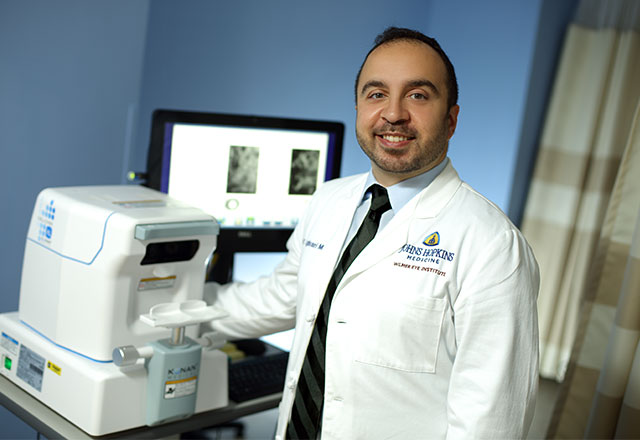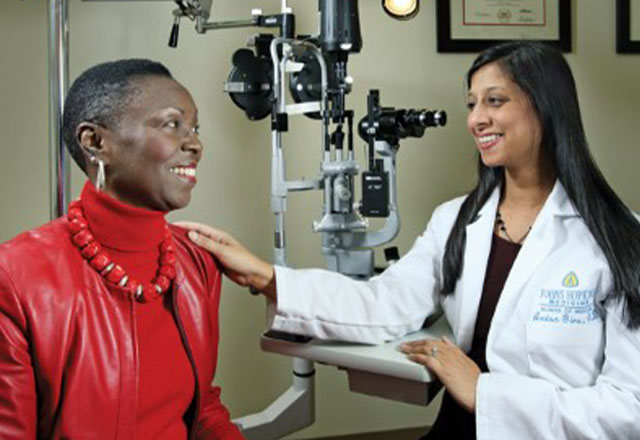Ocular Surface Disease and Dry Eye Clinic
The Ocular Surface Disease and Dry eye Clinic is dedicated to providing state of the art medical, procedural and surgical care for patients suffering from ocular surface diseases and dry eye. We offer cutting-edge diagnostic testing, contemporary medical and procedure-based treatments and surgery for the management of conditions involving the cornea, conjunctiva and eyelids.
Meet our Co-Directors, Dr. Lee Guo and Dr. Michelle Hessen
We evaluate patients individually to understand the signs and symptoms as well as considering any possible contributing systemic conditions. We strive to provide excellent medical management, eyelid procedures, and PROSE treatment/scleral lenses to control the ocular surface conditions and improve patients’ quality of life.

Ocular Surface Disease Procedures
Microblepharoexfoliation
When traditional warm a spinning micro-sponge on a hand-held device that gently brushes and debrides the eyelid margins in order to remove stubborn scurf, debris, and stuck-on biofilm. This treatment is particularly effective acompresses and at-home eyelid hygiene scrubs are insufficient against chronic blepharitis and MGD, BlepEx is an effective procedure performed in-office. BlephEx is a form of microblepharoexfoliation that involvesgainst Demodex blepharitis. Each procedure session takes about 6-8 minutes and is typically repeated on a monthly to biannual basis depending on disease severity.

Intense Pulsed Light Therapy
IPL treats Meibomian Gland Dysfunction (MGD), especially when associated with Ocular Rosacea. The Meibomian glands exist in vertical columns throughout the upper and lower eyelids, and generate the lipid/oily layer of our tears that prevent tear evaporation. MGD is a common pathological state in which these glands become clogged and stop secreting lipids naturally. IPL directly liquifies obstructions and hardened lipids trapped within each Meibomian gland in order to restore lipid secretion and decrease eyelid margin redness and inflammation. During the procedure, both eyes are closed and shields are placed over them to protect against light pulse radiation. Next, a thin layer of cooling gel is applied to the treatment area and a small hand-held device is used to administer targeted light pulses across both upper and lower eyelids. After the IPL treatment is complete, Meibomian glands along the eyelids are gently expressed in-office by the doctor in order to restore normal oil flow back onto the tear film and ocular surface.

PROSE
Scleral lenses are oversized rigid contact lenses filled with sterile saline. Upon insertion, they rest upon the sclera (white part of your eyes) and create a constant moisture chamber on top of the cornea. Prosthetic Replacement of the Ocular Surface Ecosystem (PROSE) treatment is offered to patients with severe ocular surface diseases and dry eye conditions that fail to improve with all other available treatments. A reservoir of sterile saline solution rests between the back of the lens surface and the cornea. This creates an environment that continuously hydrates the cornea and rehabilitates chronically damaged ocular surfaces. PROSE is FDA-approved for supporting or replacing impaired ocular surface system functions that protect and enable vision. PROSE lenses restore vision, support corneal healing, reduce dry eye symptoms, and improve quality of life in patients suffering from complex corneal disease and irregularities. PROSE is custom-designed by BostonSight, with Wilmer Eye Institute being one of the few institutions in the country that currently offers PROSE treatments. Scleral lenses are fit and evaluated by Doctors of Optometry. Dr. Michelle Hessen and Dr. Anisa Gire have both completed PROSE fellowship training at the Boston Foundation for Sight.

Thermal Pulsation
LipiFlow is a procedure-based treatment for patients suffering from MGD. Its vectored thermal pulse technology system gently applies heat and peristaltic motion to both upper and lower eyelids within 10 minutes. One single LipiFlow procedure removes gland obstructions and stagnant content as the inner and outer eyelids are heated and pulse expressed simultaneously. Hardened oils within the Meibomian glands are liquefied and pushed up and out of the gland orifices. The LipiScan Dynamic Meibomian Imager provides high definition meibography images of the Meibomian glands in order to gauge prognosis by evaluating the structure and severity of MGD and gland atrophy before considering LipiFlow.

Meibomian Gland Probing
Meibomian gland expression and intraductal probing are performed in-office using specialized instruments during a slit lamp examination. Topical anesthetic eye drops are first applied to each eye. The Meibomian glands within the upper and lower eyelids are then gently squeezed from bottom to top in order to express and unclog stubborn debris trapped within each viable group of glands. Intraductal probing and dilation is sometimes utilized prior to expression when the Meibomian orifice is severely scarred or keratinized.

Punctal Cautery
Tears naturally drain out of four openings in the nasal corner of our eyes. Closing them off allows for more natural and artificial tears to remain on the ocular surface in order to alleviate dry eye symptoms. Punctal plugs exist in two main types: (1) permanent but removable (silicone) and (2) temporary and dissolvable (collagen). Plugs are inserted during a slit lamp exam with your eye doctor, and patients should experience minimal discomfort during this minor procedure. The plugs are smaller than a grain of rice, less than 1 mm, and once in place, they should not be noticeable and only need to be replaced if they fall out. If you benefit from plugs, permanent closure is an option via cautery procedure done in-office or at a surgical center under local injectable anesthesia.

Request an Appointment
Schedule by Phone
New and existing patients: 410-955-5080



